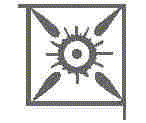North-west Star
North-east Star
Figure 1.
The "rays" are the lines which emanate from the center of the "stars"
similar to wheel spokes
Figure 2.
The North-west star viewed as a "clock face"

